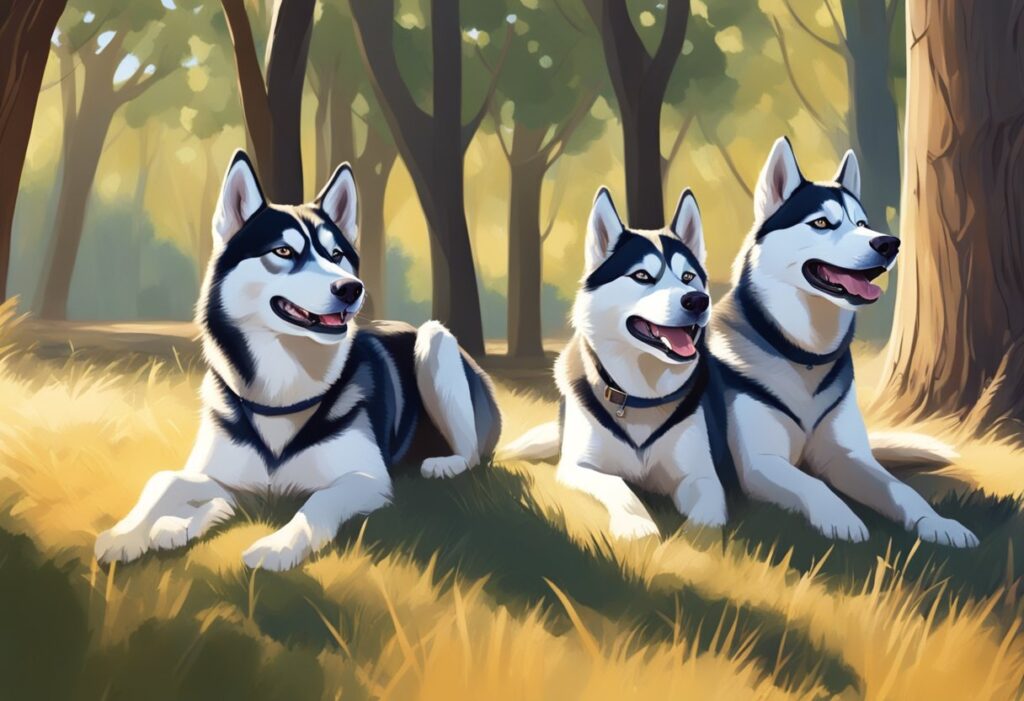Huskies, renowned for their thick fur coats and ice-blue eyes, are often associated with snowy landscapes and frigid temperatures. These dogs, originally bred as sled dogs in Siberia, have adapted to survive in extreme cold. Yet, many Huskies now live in warmer climates, raising concerns about their ability to cope with hot weather.

While Huskies possess a double coat that insulates them against cold, this same feature can make hot weather challenging. Their bodies are designed to retain heat, which can be problematic in high temperatures. Owners must be vigilant in monitoring their Husky’s comfort and health during warm seasons.
Despite their cold-weather heritage, Huskies can adapt to warmer climates with proper care. Providing shade, fresh water, and limiting outdoor activities during peak heat hours are essential strategies. Regular grooming to remove excess undercoat can also help Huskies better manage higher temperatures.
Key Takeaways
- Huskies’ thick coats, designed for cold climates, can pose challenges in hot weather
- Proper care and management are crucial for Huskies living in warm environments
- Strategies like providing shade, water, and grooming can help Huskies adapt to heat
Understanding Huskies’ Natural Climate and Adaptations
Siberian Huskies are uniquely equipped for cold environments. Their thick double coat provides excellent insulation, allowing them to thrive in frigid temperatures.
Siberian Huskies: Bred for the Cold
Siberian Huskies originated in northeastern Asia, where they were developed by the Chukchi people for sled pulling in harsh Arctic conditions. These dogs are built to withstand extreme cold, with compact bodies that conserve heat efficiently.
Their almond-shaped eyes are designed to squint, protecting them from snow and icy winds. Huskies have a higher metabolism than many other breeds, generating more body heat to stay warm in freezing climates.
Their paws are equipped with fur between the toes, providing insulation and traction on icy surfaces. This adaptation helps prevent snow from building up between their paw pads.
The Insulating Properties of a Husky’s Coat
A Husky’s coat is its primary defense against cold weather. The double-layered fur consists of a dense, woolly undercoat and a longer, coarser topcoat.
The undercoat traps warm air close to the skin, creating an insulating layer. The topcoat repels water and snow, keeping the undercoat dry and effective.
During warmer months, Huskies shed their undercoat to regulate body temperature. This process, known as “blowing coat,” occurs twice a year.
The coat’s insulating properties can pose challenges in hot weather. Huskies rely on panting and finding shade to cool down, as their coat limits heat dissipation through the skin.
Risks of Heat Exposure in Huskies
Huskies face several health risks when exposed to high temperatures. Their thick double coats and cold-weather adaptations can make them particularly vulnerable to overheating and related complications in hot climates.
Signs of Overheating and Dehydration
Huskies may exhibit excessive panting, drooling, and lethargy when overheated. Their gums and tongue can become bright red or purple. Dehydration signs include dry nose, sunken eyes, and loss of skin elasticity.
Body temperature above 103°F (39.4°C) indicates heat stress. Huskies may become unsteady, vomit, or have diarrhea as their condition worsens. In severe cases, seizures or collapse can occur.
Owners should check for these symptoms regularly in warm weather. Immediate cooling and veterinary care are crucial if heat exhaustion is suspected.
Preventing Heatstroke and Sunburn
Limit outdoor activity during peak heat hours. Provide constant access to fresh water and shaded areas. Consider cooling mats or kiddie pools for relief.
Never leave huskies in parked cars, even briefly. Indoor temperatures should be kept comfortable with air conditioning when needed.
Apply pet-safe sunscreen to exposed skin, especially on the nose and ear tips. Light-colored huskies are more susceptible to sunburn.
Regular grooming helps remove loose undercoat, improving air circulation. However, avoid shaving huskies as their coat provides insulation and UV protection.
Exercise huskies in cooler morning or evening hours. Carry water on walks and take frequent breaks in shaded spots.
Keeping Your Husky Cool and Hydrated
Huskies require special attention during hot weather to maintain their health and comfort. Providing effective cooling methods and ensuring proper hydration are essential for their wellbeing in warm climates.
Effective Cooling Techniques
Shade is crucial for Huskies in hot weather. Provide a shaded outdoor area or keep them indoors during the hottest parts of the day. Cool tiles or concrete surfaces offer relief for overheated paws. A kiddie pool filled with shallow water allows Huskies to cool off as needed.
Wet towels draped over the dog’s body can help lower their temperature. Avoid placing towels on the head, as this can trap heat. Brushing out the undercoat regularly helps with air circulation and natural cooling.
Indoor cooling options include fans and air conditioning. Some Huskies enjoy lying near air vents or on cooling mats designed for pets. Never leave a Husky in a parked car, even with windows cracked, as temperatures can quickly become dangerous.
Importance of Hydration
Access to fresh, cool water is vital for Huskies in hot weather. Provide multiple water bowls in shaded areas both indoors and outdoors. Refresh the water frequently to ensure it stays cool and clean.
Huskies may not drink enough on their own in hot conditions. Encourage hydration by adding ice cubes to water bowls or offering frozen treats made from diluted low-sodium broth. Some Huskies enjoy drinking from a slowly trickling hose or fountain.
Monitor for signs of dehydration such as excessive panting, drooling, or lethargy. If a Husky shows these symptoms, offer water immediately and move them to a cooler area. For severe cases or if symptoms persist, consult a veterinarian promptly.
Exercise and Outdoor Activities in Warmer Climates

Huskies require careful management for exercise and outdoor activities in warm weather. Proper planning and precautions are essential to keep these cold-adapted dogs safe and comfortable in higher temperatures.
Safe Exercise Practices in Heat
Limit exercise to cooler times of day, such as early morning or evening. Keep walks short, around 15-20 minutes. Choose shaded routes and avoid hot pavement. Bring water and offer frequent breaks.
Monitor your husky closely for signs of overheating:
- Excessive panting
- Drooling
- Lethargy
- Vomiting
Stop activity immediately if these symptoms occur. Cool your dog gradually with room temperature water. Avoid ice cold water, as it can shock the system.
Indoor exercise is preferable on very hot days. Try puzzle toys or indoor fetch to provide mental and physical stimulation without heat exposure.
Planning Outdoor Activities
Schedule outdoor playtime during cooler hours. Provide constant access to fresh water and shaded areas. A kiddie pool filled with cool water can offer relief.
Limit sun exposure, especially between 10 AM and 4 PM when UV rays are strongest. Apply pet-safe sunscreen to exposed skin, like noses and ears.
Create a cool indoor environment with proper ventilation. Use fans or air conditioning to maintain a comfortable temperature. Ensure your husky has a cool spot to rest after outdoor activities.
Avoid leaving huskies outside for extended periods in summer months. Their thick double coats make them prone to overheating. When outdoors, supervise closely and keep sessions brief.
Health Management and Huskies in Hot Weather
Proper care and vigilance are crucial for keeping Huskies healthy in hot climates. Owners must monitor their dogs closely and take proactive steps to prevent heat-related issues.
Recognize and Addressing Heat-Related Health Issues
Huskies can quickly overheat in warm weather. Signs of heatstroke include excessive panting, drooling, and lethargy. More severe symptoms may involve vomiting, collapsing, or a rapid heartbeat.
If a Husky shows these signs, move them to a cool area immediately. Offer fresh water and apply cool (not ice-cold) water to their body, focusing on the neck, armpits, and groin areas.
Never leave a Husky in a parked car, even for short periods. The temperature inside can rise rapidly, leading to life-threatening conditions.
Routine Grooming and Skincare for Huskies
Regular brushing helps remove loose fur, improving air circulation to the skin. This is especially important during shedding seasons.
Huskies can get sunburned, particularly on their noses and ears. Apply pet-safe sunscreen to these areas when spending time outdoors.
Keep your Husky’s paws protected from hot surfaces. Walk them during cooler parts of the day and avoid asphalt or concrete that’s been baking in the sun.
Provide a cool, shaded area for your Husky to rest. A kiddie pool filled with cool water can offer relief on particularly hot days.


Leave a Reply